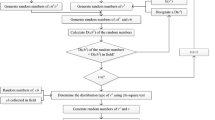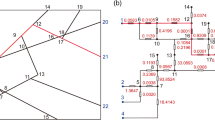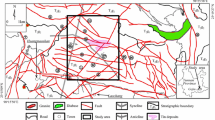Abstract
The identification and reconstruction of karst fracture networks have always been an important and difficult research topic in the field of karst groundwater resources and geological environment protection. Based on the original surface fracture data obtained in Zhangfang, Fangshan district in southwest of Beijing, and the surface fracture records processed through the Kriging interpolation method, we propose a method for the construction of a flow path based on a disk model. We focus on identifying the flow path in a three-dimensional fracture structure and underground fracture data obtained by the Monte Carlo method. The flow path along the fracture generalized by the disk model is simulated using a directed graph data structure and is stored in an adjacency matrix. To meet the demands of fast intersection operation with large-scale fracture data and to improve the operating efficiency of a karst fracture simulation system, this paper first divides the study space into smaller blocks and then uses a three-dimensional R-tree index algorithm to reduce the time required to traverse each sampling point. Finally, based on the sampled surface fracture data from Zhangfang, this paper studies the distribution model for a three-dimensional fracture space with the assistance of a remote sensing geological survey, fine geological survey of key karst areas, and sampling analysis. The algorithm for building the path of karst fractures was also simulated. It provides a visualization analysis approach to study the karst development mechanism and numerical simulation of karst water fractures in Zhangfang.



















Similar content being viewed by others
References
Baecher GB (1977) Statistical description of rock properties and sampling. In Proc. of the U.S. symposium on rock mechanics
Batu V (2009) Fracture control of ground water flow and water chemistry in a rock aquitard. Ground Water 47:488–4U1
Berkowitz B (2002) Characterizing flow and transport in fractured geological media: a review. Adv Water Resour 25:861–884
Brkic Z, Kuhta M, Hunjak T (2018) Groundwater flow mechanism in the well-developed karst aquifer system in the western Croatia: insights from spring discharge and water isotopes. Catena 161:14–26
Chen CX (2011) Groundwater hydraulics. China University of geosciences press, Wuhan
Dershowitz WS, Einstein HH (1988) Characterizing rock joint geometry with joint system models. Rock Mech Rock Eng 21:21–51
Dong Y, Ju YW, Zhang YX (2014) Characteristics of joints in karst area and their influence on karstification in Zhangfang in Fangshan region of Beijing. J Univ Chin Acad Sci 31:783–790
Ford D, Williams P (2007) Karst hydrogeology and geomorphology. United Kingdom. Wiley, Chichester
Gellasch CA, Bradbury KR, Hart DJ, Bahr JM (2013) Characterization of fracture connectivity in a siliciclastic bedrock aquifer near a public supply well (Wisconsin, USA). Hydrogeol J 21:383–399
He SH (1997) Research on a model of seepage flow of fracture networks and modelling for the coupled hydro-mechanical process in fractured rock masses. In Computer methods and advances in Geomechanics, Vol 2, 1137–1142
Hyman JD, Aldrich G, Viswanathan H, Makedonska N, Karra S (2016) Fracture size and transmissivity correlations: implications for transport simulations in sparse three-dimensional discrete fracture networks following a truncated power law distribution of fracture size. Water Resour Res 52:6472–6489
Karimzade E, Sharifzadeh M, Zarei HR, Shahriar K, Seifabad MC (2017) Prediction of water inflow into underground excavations in fractured rocks using a 3D discrete fracture network (DFN) model. Arab J Geosci, 10
Li HB (2008) Gibbs sampling in Markov chain Monte Carlo-based algorithm. Wu han: Hubei University
Li ZY, Wang MY, Zhao JH (2014) Optimizing fracture intersection analysis procedure in 3D fracture network seepage simulation. J China Coal Soc 39:2286–2292
Liu HM, Wang MY (2010) The computer processing and visualization system for 3-D fracture networks. In Proceedings of 2010 3rd Ieee international conference on computer science and information technology, 139–144
Long JCS, Gilmour P, Witherspoon PA (1985) A model for steady fluid-flow in random 3-dimensional networks of disc-shaped fractures. Water Resour Res 21:1105–1115
Medici G, West LJ, Mountney NP (2016) Characterizing flow pathways in a sandstone aquifer: tectonic vs sedimentary heterogeneities. J Contam Hydrol 194:36–58
Qiao XJ, Hou QL, Ju YW (2014) Research about the control of geological structure on karst groundwater system in Zhangfang, Beijing. Carsologicasinica 33:184–191
Robertson AM (1970) The interpretation of geological factors for use in slope theory
Snow DT (1965) A parallel plate model of fractured permeable media
Wang H (2016) Research on three dimensional visualization technologies. In Proceedings of the 2016 4th international conference on advanced materials and information technology processing, 261–265
Zhao TY (2014) Markov chain Monte Carlo-based stability analysis for Pingzishan landslide. 31–32. Cheng du: Southwest jiao tong University
Funding
This study was supported by the Beijing Natural Science Foundation (Grant No. 8172046), the National Natural Science Foundation of China (Grant No. 41771478), and the Hebei Province Natural Science Fund (Grant No. D2016210008).
Author information
Authors and Affiliations
Corresponding author
Additional information
Editorial handling: Chen Mingjie
Rights and permissions
About this article
Cite this article
Rui, X., Yu, T. An efficient karst fracture seepage path construction algorithm based on a generalized disk model. Arab J Geosci 12, 262 (2019). https://doi.org/10.1007/s12517-019-4412-2
Received:
Accepted:
Published:
DOI: https://doi.org/10.1007/s12517-019-4412-2




